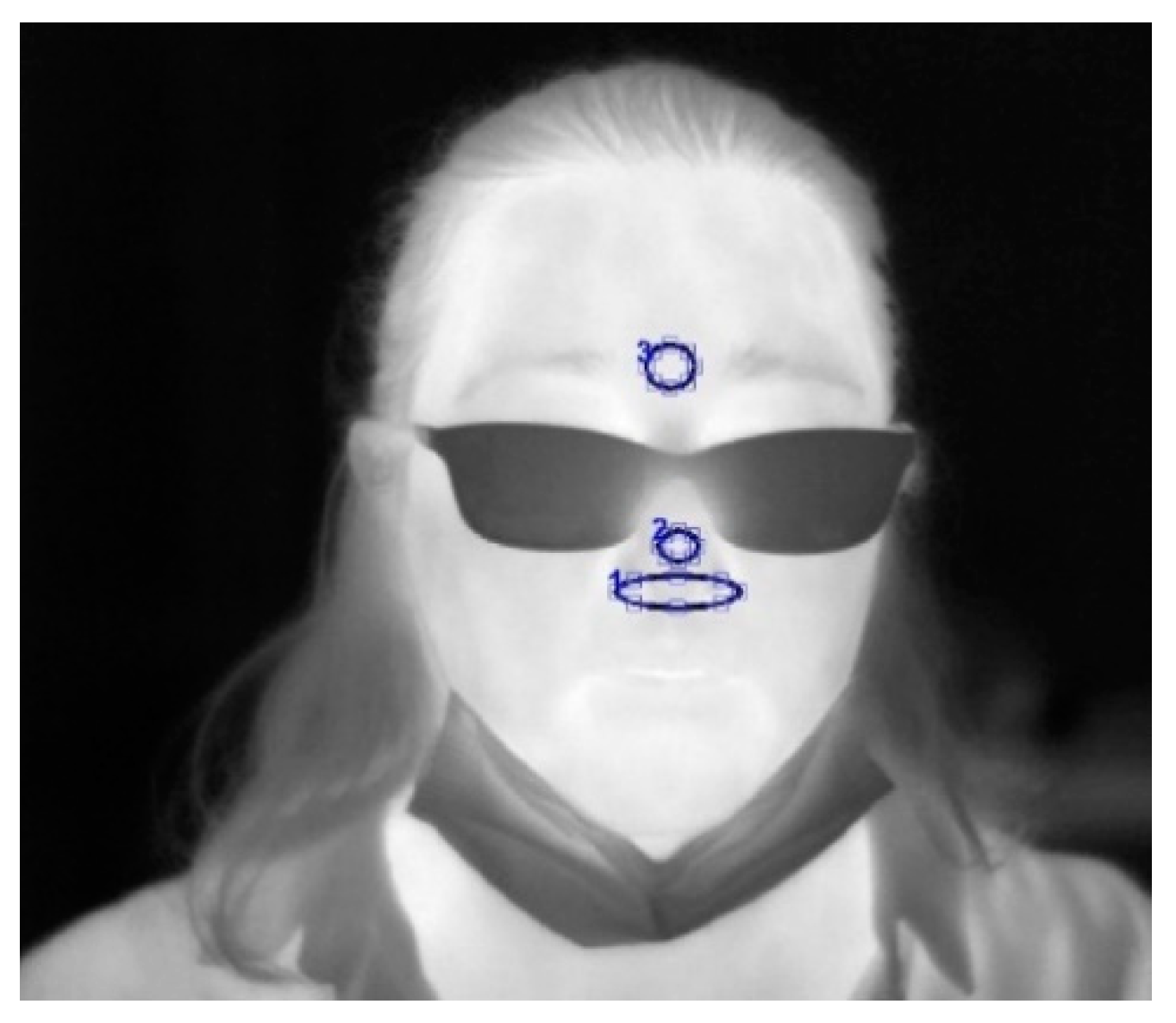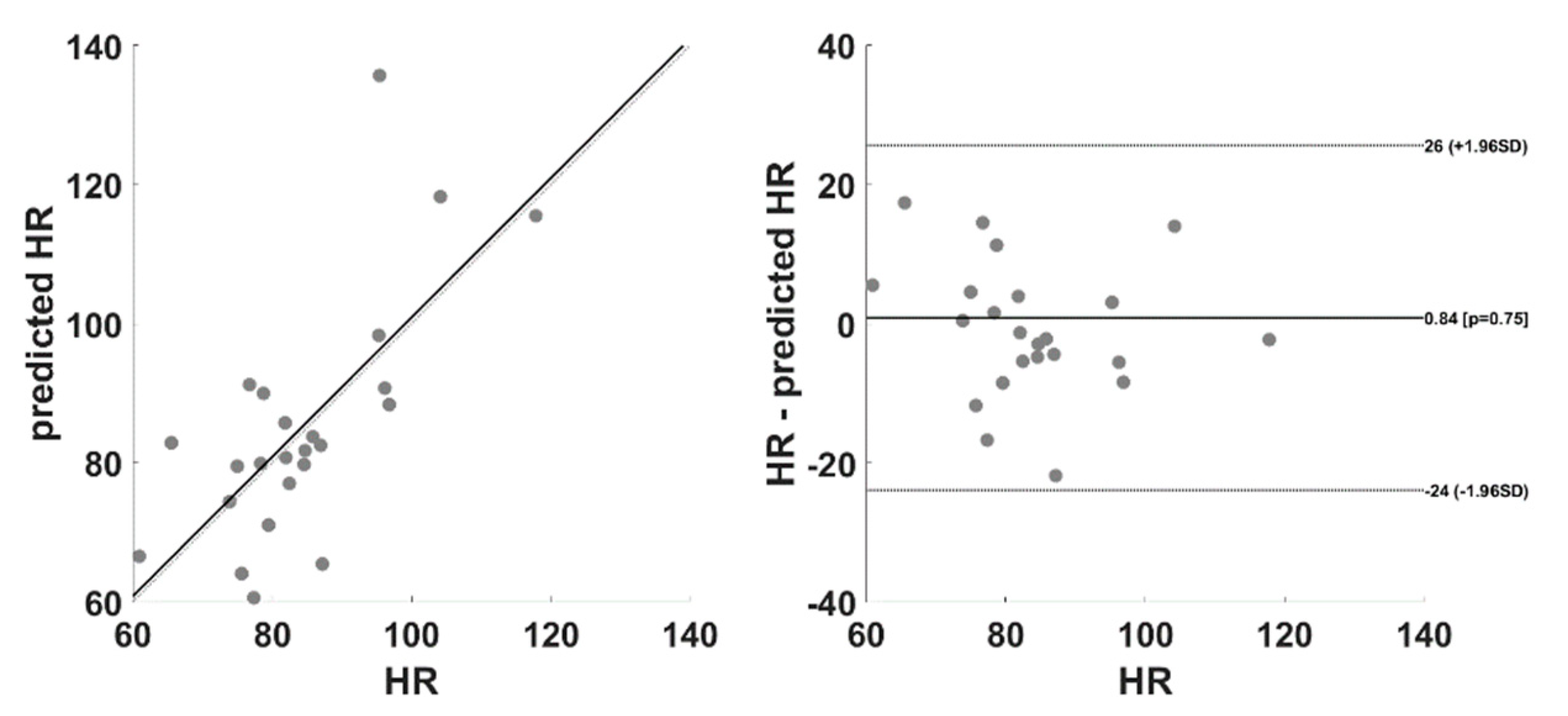Is It Possible to Estimate Average Heart Rate from Facial Thermal Imaging? †
Abstract
:1. Introduction
2. Material and Methods
2.1. Experimental Procedure and Data Acquisition
2.2. Data Preprocessing
2.3. Machine Learning Procedure
3. Results and Discussion
4. Conclusions
Author Contributions
Funding
Institutional Review Board Statement
Informed Consent Statement
Data Availability Statement
Conflicts of Interest
References
- Ruiz-Fernández, D.; Marcos-Jorquera, D.; Gilart-Iglesias, V.; Vives-Boix, V.; Ramírez-Navarro, J. Empowerment of Patients with Hypertension through BPM, IoT and Remote Sensing. Sensors 2017, 17, 2273. [Google Scholar] [CrossRef] [PubMed] [Green Version]
- Perpetuini, D.; Filippini, C.; Cardone, D.; Merla, A. An Overview of Thermal Infrared Imaging-Based Screenings during Pandemic Emergencies. Int. J. Environ. Res. Public Health 2021, 18, 3286. [Google Scholar] [CrossRef] [PubMed]
- Wascher, C. Heart Rate as a Measure of Emotional Arousal in Evolutionary Biology. Philos. Trans. R. Soc. B Biol. Sci. 2021, 376. [Google Scholar] [CrossRef] [PubMed]
- Blöcher, T.; Schneider, J.; Schinle, M.; Stork, W. An Online PPGI Approach for Camera Based Heart Rate Monitoring Using Beat-to-Beat Detection. In Proceedings of the 2017 IEEE Sensors Applications Symposium (SAS), Glassboro, NJ, USA, 13–15 March 2017; pp. 1–6. [Google Scholar]
- Vardasca, R.; Simoes, R. Current issues in medical thermography. In Topics in Medical Image Processing and Computational Vision; Springer: Dordrecht, The Netherlands, 2013; pp. 223–237. [Google Scholar]
- Ioannou, S.; Gallese, V.; Merla, A. Thermal Infrared Imaging in Psychophysiology: Potentialities and Limits. Psychophysiology 2014, 51, 951–963. [Google Scholar] [CrossRef] [PubMed] [Green Version]
- Magalhaes, C.; Mendes, J.; Vardasca, R. Meta-Analysis and Systematic Review of the Application of Machine Learning Classifiers in Biomedical Applications of Infrared Thermography. Appl. Sci. 2021, 11, 842. [Google Scholar] [CrossRef]
- Filippini, C.; Cardone, D.; Perpetuini, D.; Chiarelli, A.M.; Gualdi, G.; Amerio, P.; Merla, A. Convolutional Neural Networks for Differential Diagnosis of Raynaud’s Phenomenon Based on Hands Thermal Patterns. Appl. Sci. 2021, 11, 3614. [Google Scholar] [CrossRef]
- Diakides, M.; Bronzino, J.D.; Peterson, D.R. Medical Infrared Imaging: Principles and Practices; CRC Press: Boca Raton, FL, USA, 2012; ISBN 1-4398-7250-3. [Google Scholar]
- Perpetuini, D.; Cardone, D.; Filippini, C.; Chiarelli, A.M.; Merla, A. A Motion Artifact Correction Procedure for FNIRS Signals Based on Wavelet Transform and Infrared Thermography Video Tracking. Sensors 2021, 21, 5117. [Google Scholar] [CrossRef] [PubMed]
- Kohavi, R.; John, G.H. Wrappers for Feature Subset Selection. Artif. Intell. 1997, 97, 273–324. [Google Scholar] [CrossRef] [Green Version]


Publisher’s Note: MDPI stays neutral with regard to jurisdictional claims in published maps and institutional affiliations. |
© 2021 by the authors. Licensee MDPI, Basel, Switzerland. This article is an open access article distributed under the terms and conditions of the Creative Commons Attribution (CC BY) license (https://creativecommons.org/licenses/by/4.0/).
Share and Cite
Perpetuini, D.; Di Credico, A.; Filippini, C.; Izzicupo, P.; Cardone, D.; Chiacchiaretta, P.; Ghinassi, B.; Di Baldassarre, A.; Merla, A. Is It Possible to Estimate Average Heart Rate from Facial Thermal Imaging? Eng. Proc. 2021, 8, 10. https://doi.org/10.3390/engproc2021008010
Perpetuini D, Di Credico A, Filippini C, Izzicupo P, Cardone D, Chiacchiaretta P, Ghinassi B, Di Baldassarre A, Merla A. Is It Possible to Estimate Average Heart Rate from Facial Thermal Imaging? Engineering Proceedings. 2021; 8(1):10. https://doi.org/10.3390/engproc2021008010
Chicago/Turabian StylePerpetuini, David, Andrea Di Credico, Chiara Filippini, Pascal Izzicupo, Daniela Cardone, Piero Chiacchiaretta, Barbara Ghinassi, Angela Di Baldassarre, and Arcangelo Merla. 2021. "Is It Possible to Estimate Average Heart Rate from Facial Thermal Imaging?" Engineering Proceedings 8, no. 1: 10. https://doi.org/10.3390/engproc2021008010
APA StylePerpetuini, D., Di Credico, A., Filippini, C., Izzicupo, P., Cardone, D., Chiacchiaretta, P., Ghinassi, B., Di Baldassarre, A., & Merla, A. (2021). Is It Possible to Estimate Average Heart Rate from Facial Thermal Imaging? Engineering Proceedings, 8(1), 10. https://doi.org/10.3390/engproc2021008010











